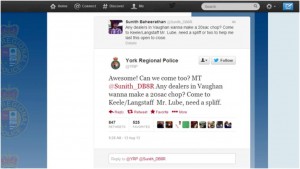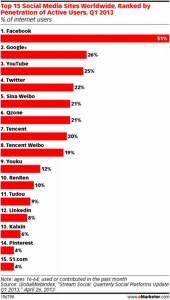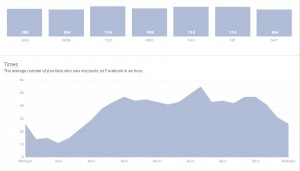 Chris Byrnes – ByrnesMedia
Chris Byrnes – ByrnesMedia
On 14 September last year, Facebook reached the 1 billionth registered user. 28 year old Mark Zukerberg and about 100 Facebook Executives gathered on the 2nd floor of Building 17 at Menlo Park California to watch the number of users reach 1 out of every 7 people in the world. Facebook grows by about 1,000 new users a minute according to those that track these numbers. As of last week that number had grown to 1.5 billion registered users of Facebook. What’s more dramatic is that 50% of all registered users log in to Facebook every day, says Sheryl Sandberg the CEO of Facebook, and that does not include Facebook Connect log ins, only those people that visit the Facebook website.
Facebook has been working hard over the past 18 months to find ways to make their advertising tools more attractive to large advertisers and advertising agencies. But saying they have 1.5 billion users is such an abstract number that it does not seem to be working as well as they had planned. I am told that over the past few months Facebook has been making changes and now feel they have found the magic bullet, and I’ll get to that in a moment.
What traditional media needs to be aware of, and perhaps concerned about, is Facebook’s desire to actively go after media budgets from traditional advertising platforms. Here is what Sheryl Sandberg said in Davos Switzerland in 2012. “I think this was the year that we changed from being experimental ad platform to really being able to go big and we are going big in lots of ways. What Facebook does is we’re a place where users express themselves and we’re a place where people share. And when you think about building brands, not just giving someone something they search but before they search. When they’re talking about who they are and affiliating, and finding things typical demand generation, which is still 90% of global ad spenders. I think we’re best property anywhere, with any media to do that because friends want you to affiliate. They want you to say, I am a Starbucks drinker. I like Starbucks latte and they want you to tell their friends about it. We’re ready to go big because we really want that kind of very authentic two-way dialogue with our users and we’re excited to help brands do that and help people interact to them in ways that they’re excited about.”
In the past few weeks Facebook has been releasing regional data for the very first time. For example one out of every three people, or more than 128 million people in the USA alone, visit Facebook each and every day. This is all designed to help advertisers better understand how consumers are using this social network. This appears to be part of a larger strategy to go after advertising dollars from traditional media such as television, radio and newspapers. “We would like to be able to be explicit and say this is the amount of people you can reach tomorrow or the amount of people you can reach when you are launching a new movie” said Carol Everson, Facebook Vice President of Global Marketing Solutions. The average time spent each day with digital media will most likely surpass television viewing for the first time ever at some point later this year. Some agencies are suggesting that as much as 40% or more of their business could be invested in digital within the next 12 months. Large operations such as Facebook are working frantically to ensure they get a chunk of this money.
Facebook is constantly evolving and changing which is a real problem for all the software providers who interface with Facebook in one fashion or another. Over the past 12 months they have conducted lots of on-line surveys with users seeking views on potential changes to the look and functionality of the product. In their most recent survey over 400,000 people responded and we are being told that we can expect to see Facebook evolve under the guidance of CEO Sheryl Sandberg.
Let me be clear, I do think Facebook has a place and can be a useful tool for individuals and companies to connect, communicate and market providing it is used correctly and strategically. The biggest mistake any radio station can make in my opinion is driving listeners to Facebook as opposed to using Facebook to drive audience to the radio station or the station controlled assets such as the station website. Remember that the only people who are getting rich on the backs of all the traffic your radio station drives to Facebook are the very people who are trying to find ways to get more and more of your regional and national advertising from traditional media and onto Facebook.
Here are 10 other suggestions that may help you moving forward as Facebook and other social networks look to take more advertising dollars from traditional media to their platforms. This is by no means the definitive list but it is a starting point:
- Establish an easy to understand and realistic digital media strategy. All your staff need to be singing from the same hymn book when it comes to social. Unless you clearly communicate the strategy and who needs to do what, you may end up with mixed messages being sent out on multiple platforms and that is likely to confuse and annoy people.
- Establish who owns what: The radio station should own and control all your social media accounts. I recommend that tweets and posts come from the station account and not the DJ’s personal account as that can be confusing and the station may have less control over the content. Also be sure to clearly communicate your policies and rules when it comes to social media, so there is no misunderstanding regarding what is appropriate and acceptable to post on social media. My rule of thumb is if I would not want my grandmother to read it then it does not belong on any social media platform. That may be too conservative for your strategy and that’s fine, but make sure your staff know where the line is and what happens if it is crossed. There is a young man in Toronto who sent out a message looking to score and invited people to come to his employer’s business. He is now out of a job.

- Understand that social media is in itself social. This means it is about interacting and not shouting or broadcasting. For radio broadcasters this can be a difficult concept to understand, and perhaps one of the reasons that some broadcasters have a difficult time being effective on social media. Remember anything you post needs to be relevant and beneficial to your end user. If you fail too many times they will unfriend you. Sometime less is more when it comes to social.
- You cannot outsource your social media content: Stations that look to outsource their social media marketing lose that personal connection between the announcer and the listener. A radio station has a special and unique relationship with its listeners, and this cannot be outsourced. There are lots of companies who promise to take control of your social media marketing and they will send content at all hours of the day. While this may work for some companies it does not, in my opinion, work for radio and you need to keep it in house. You are better to invest in some training and help your staff understand how to make the most of connecting with your audience.
- It takes time: It will take a long time to get a decent number of followers on any social media platform. Someone once told me that it is a marathon not a race and those stations that go out and buy a fan base are unlikely to be successful long term because your content and interaction will only be of interest to the true fans of your station and the fake fans will soon drift away.
- Be strategic about which platforms you are on: At last count there are over 200 social media platforms with 1 million or more users. Google+ was one of the fastest growing platforms last month, but that does not mean you should be there. Unless you have a huge social media department you cannot and should not be on lots of social media platforms. Pick the most popular ones and put your efforts where most of your potential audience are likely to be. In North America the most popular are Facebook, Twitter, LinkedIn and Pinterest. Below is a chart of the most popular worldwide social media platforms, which is somewhat slanted because of the rapid growth of social in China where local Chinese social networks garnered among the greatest percentage of users worldwide, a reflection of both the vastness of the social audience in China and the limited availability of foreign properties, like Facebook, in the country. Our advice is that you start with one platform, master that and then expand to the next platform.

- Don’t look boring: Do not fall into the trap of just posting text. Pictures can be very powerful especially on Facebook. Don’t forget video and graphics can also encourage more people to view the content and perhaps repost or comment. Also don’t be afraid to share posts you like and engage by commenting on posts from time to time. Do this and you will look less predictable and it will probably be less boring for you as well. By experimenting you are more likely find out the type of content that is more engaging for your audience.
- Ensure you always respond: The quickest way to lose potential listeners is when the station fails to respond to a question or comment about your station or product. If someone asks a question make sure your station responds in a timely manner. This is basic customer service and should be obvious to most people, but you will be amazed how many times I see questions or comments on Facebook or other social media about a radio station that go unanswered. Perhaps some stations are afraid and even worry that competitors or disgruntled fans are saying negative things about them. But unless you are part of the conversation you cannot defend yourself or put your view point forward. I suspect that some stations are concerned about potentially adding fuel to the fire when someone posts a negative comment about a station. But the real downside is if you do not respond others will think you don’t care and may also leave.
- Social Media is only part of the answer: When it comes to marketing I encourage stations to also look at the other marking options they have available to them, and not to put all their eggs into the social basket. I am a big fan of building a database of your listeners and potential listeners and while it may not seem as sexy as social, it is effective. Frankly you should be doing both because email is a very powerful, and if done correctly, a social tool way to reach listeners and encourage tuning to your station. Send out a weekly newsletter providing the content is of value. Make your listener club members feel special by giving them advance notice of a special event or contest. When they feel like they are part of a special insiders club they will likely be more loyal to your station as opposed to others. If they should get a BBM ballot or be asked to carry a PPM meter it could help your ratings.
- Make sure your staff knows the best times to be posting to social media. You can do this by going to Facebook Insights to see which days and which hours the greatest number of your fans are viewing your posts. Look at reach and engagement to see which posts are the most effective. Also try and spend no more than 30 minutes at the time of day when you are the most creative and write your posts and then use one of the many on-line scheduling tools to automatically send out your posts at the times you determine.

I hope you find the above suggestions helpful, and if you have any other ideas you would like to pass along please leave a comment at the bottom of this article on our website at www.byrnesmedia.com and we will post them on our website and expand the knowledge base.


